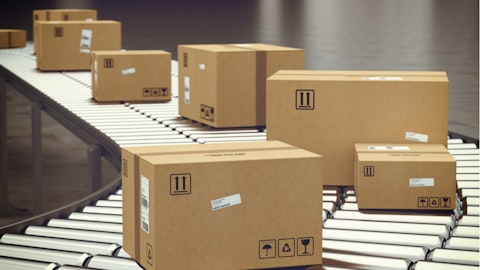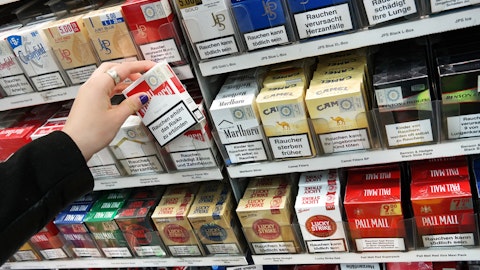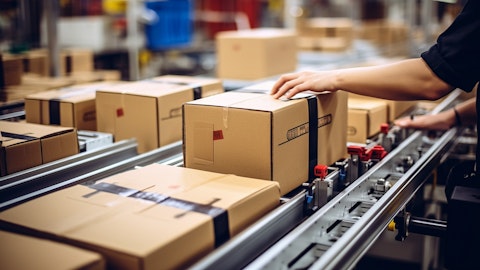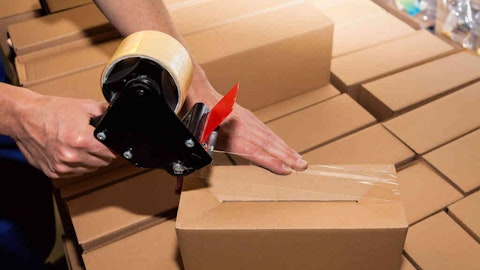Jeff Zekauskas: Thanks very much. I got a two-part question. The first part is when you look at Liquibox and its growth initiatives since you’ve acquired it, how would you assess it? That is — are the growth initiatives as strong as you expected or stronger or weaker? And second, on Slide 16, you show your Protective prices 2% lower after they’ve been positive. Can you discuss what’s behind that?
Emile Chammas: All right. Let me first head off on the first question and then Dustin will take over the second one. So first of all, let’s talk about just in general what’s driving Fluids, including the Liquibox. The first piece is the CRYOVAC fluid side, we’ve been making very good inroads, both in terms of automation and driving our FlexPrep solution. We are now present into more than 25,000 stores globally by — this was a solution mostly in the U.S., and it’s been expanded. So we have that part of our portfolio that’s continuing to drive growth. On the Liquibox, as was shared in the last quarter, there were many operational issues. So we’ve addressed those. We’ve actually accelerated the integration and brought in more resources from the broader company to address that.
We’ve also re-expanded the portfolio so that we can attack a broader set of the markets, which was not accepting the limited portfolio of solutions. So we’ve put those behind us and we’ve accelerated our growth into Q3 and into next year.
Dustin Semach: And Jeff, this is a follow-on point to your point number two, on Slide 16. In general, it’s on the commentary and the prepared remarks references the pricing environment beginning to shift. If you think about resin prices and Protective is more affected by where we have from a spot perspective. The first half, it kind of came down to about the middle of the year, and then it’s trended sideways. Now it’s actually ticking up a little bit going into the fourth quarter. And so that’s really what’s reflected now is that overall intensification of — because the volumes are down, so intensifying of competition coupled with where — how rest of the trend is what’s leading to that impact. And that’s — in the commentary, we talked about 2024. That’s what’s playing into some of our thinking right now of the impacts we can potentially see into the following year.
Operator: Thank you. Please stand by for our next question. Our next question comes from Josh Spector from UBS.
Joshua Spector: Yes, hi. Thanks for taking my question. So just regarding the guidance for this year, you reiterated the midpoint of EBITDA. If you do the math in 4Q, it’s down about $100 million from 3Q, which could be an incredible abnormal seasonality. Just wondering — I understand the need to be conservative and want to be conservative on your end, but what are the moving pieces that get you to that scenario? And are customer conversations reflecting that view at all at this stage? Thanks.
Dustin Semach: Josh, I appreciate the question. And as I mentioned back in the prior remarks and the commentary just made around being cautious, again, our fourth quarter right now at this point in time kind of you think about how we came through the first half and the second half of the year. It does reflect some of the limited visibility environment that we are in right now. And so the second piece, if you go back to the prepared remarks, we talked about fourth quarter, that [technical difficulty] impact, which is primarily driven by the GDP in Europe piece of our business is also having a corresponding impact on our bottom line, which is obviously not operational. Now what could lead in terms of differences kind of how we talk about the fourth quarter, we talked about in the prior remarks, and it’s really driven by the strength of our seasonality in our business, whether it’s in the — think of it as the eCommerce cycle that can affect our Protective business or the Food cycle relative to holidays that can affect our Food business.
And so those are the two areas. The strength of that could really determine that outcome and what we’ve seen so far in the month of October that we are on track and — but obviously, more to come there. So that’s kind of the variability in outcomes.
Operator: Thank you. Please stand by for our next question. Our next question comes from Anthony Pettinari from Citi.
Anthony Pettinari: Good morning. You’ve talked about rationalizing cost to serve across the portfolio and exiting some product lines like that roll-stock business. Just wondering, with the new management approach, are there components of the business that might be larger and might have a more logical owner and maybe could help accelerate deleveraging? Or would those kinds of dispositions or asset sales or larger portfolio moves, would those be kind of outside the mandate given kind of the interim designation? Or how should we think about that?
Dustin Semach: Great question. This is Dustin speaking. So as we mentioned beforehand and kind of going back into Q2, we’ve really kicked off this effort in portfolio optimization, right? As Kevothermal was already announced, now we talked about the plant-based roll-stock business we’ve announced today, that effort is continuing and now accelerating, right, as we go from here. The mandate is really to take any action necessary to create value, whether it’s large and small. So we are looking at the entire portfolio, trying to understand what’s best fit for purpose moving forward. And then obviously, deleveraging is the primary focus. We talked about that in terms of getting — trying to get below 3.5x within the next 2 years or less and certainly opportunity to deleverage.
Now many other factors come into that perspective in terms of where we sit right now and overall, we believe to be nearing the bottom of an overall cycle. So again, we are factoring timing, factoring the kind of overall environment we’re operating within from a rate environment, debt markets, et cetera. And — but all of those things are kind of factored into the — how we are thinking about things. But just again, just to finalize that point, is this is intended to accelerate those type of actions, not decelerate it or whether they’re small or large.
Operator: Thank you. Please stand by for our next question. Our next question comes from Lawrence De Maria from William Blair.
Lawrence De Maria: Thanks. Good morning. Two quick things here. So you amended the bylaws, I guess, maybe more difficult to nominate Directors. So the question really is whether that’s preemptive or to any potential activists? And then secondly, and related to that, you’ve looked at the Protective portfolio, assuming you’re thinking about doing some pairing. So curious if you’re still looking at that? And any updates on how much of that portfolio might be considered preparing and where we are in that process? Thank you.
Dustin Semach: Hey, Larry, this is Dustin speaking. So on the first point on the 8-K we filed related to the amendments to our bylaws, that’s really related to an updated SEC rule around universal proxy. It’s very common for all kind of companies in the process of doing some form of that, which is really just combining the ability for — I won’t get to the technical details, but the ability for whether a shareholder or ourselves to raise kind of nominees and the voting aspect of it, that it consolidates on to the card and is part of improving and continuing to improve our overall corporate governance. And then the last piece when you talk about Protective portfolio, in line with the prior question, Protective, we are absolutely going to the portfolio and looking at areas where we can optimize.
Kevothermal is an example of that. I won’t give an update relative to the status of that because we are right now in the process of dissecting many different pieces, which each in their own way, take a level of effort and energy to get through, understand, obviously, viability in the market today, value and then really the disposition going forward relative to the timing. So there’s no update in terms of like a progress versus other than it’s underway, and we are accelerating the pace.



